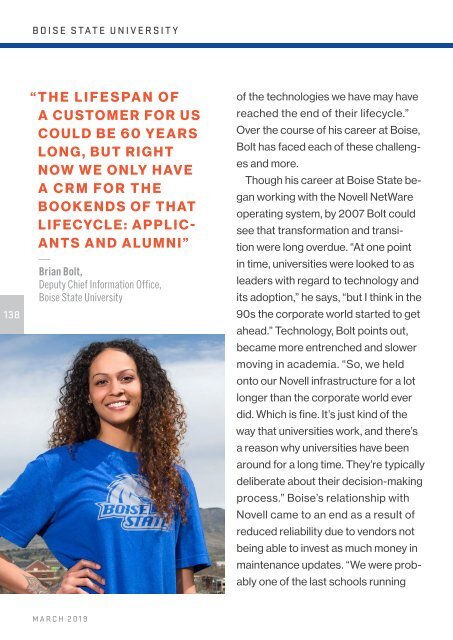Business Chief USA March 2019
You also want an ePaper? Increase the reach of your titles
YUMPU automatically turns print PDFs into web optimized ePapers that Google loves.
BOISE STATE UNIVERSITY<br />
138<br />
“THE LIFESPAN OF<br />
A CUSTOMER FOR US<br />
COULD BE 60 YEARS<br />
LONG, BUT RIGHT<br />
NOW WE ONLY HAVE<br />
A CRM FOR THE<br />
BOOKENDS OF THAT<br />
LIFECYCLE: APPLIC-<br />
ANTS AND ALUMNI”<br />
—<br />
Brian Bolt,<br />
Deputy <strong>Chief</strong> Information Office,<br />
Boise State University<br />
of the technologies we have may have<br />
reached the end of their lifecycle.”<br />
Over the course of his career at Boise,<br />
Bolt has faced each of these challenges<br />
and more.<br />
Though his career at Boise State began<br />
working with the Novell NetWare<br />
operating system, by 2007 Bolt could<br />
see that transformation and transition<br />
were long overdue. “At one point<br />
in time, universities were looked to as<br />
leaders with regard to technology and<br />
its adoption,” he says, “but I think in the<br />
90s the corporate world started to get<br />
ahead.” Technology, Bolt points out,<br />
became more entrenched and slower<br />
moving in academia. “So, we held<br />
onto our Novell infrastructure for a lot<br />
longer than the corporate world ever<br />
did. Which is fine. It’s just kind of the<br />
way that universities work, and there’s<br />
a reason why universities have been<br />
around for a long time. They’re typically<br />
deliberate about their decision-making<br />
process.” Boise’s relationship with<br />
Novell came to an end as a result of<br />
reduced reliability due to vendors not<br />
being able to invest as much money in<br />
maintenance updates. “We were probably<br />
one of the last schools running<br />
MARCH <strong>2019</strong>

















